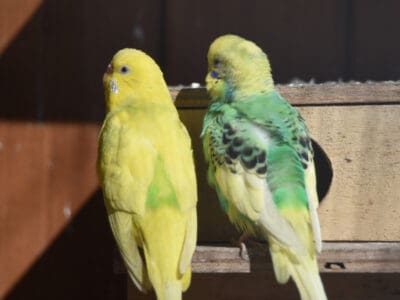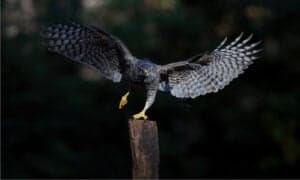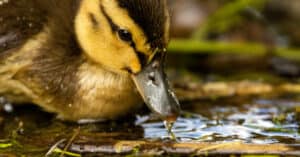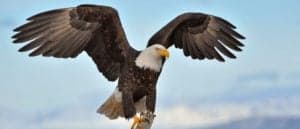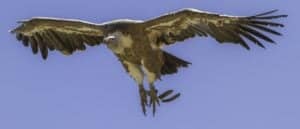Discover the 8 Types of Hawks in Maryland
@media (min-width: 481px) {
.mobile-top-content {
display: none;
}
}
#mobileTopContentCTACarouselControls { overflow: hidden; text-overflow: ellipsis; white-space: nowrap; }
.mobile-top-content .more { color: #fff; }
.mobile-top-content a { color: #fff; text-decoration: underline; }
.mobile-top-content a:hover { color: #fff; text-decoration: underline; }
@media (max-width: 480px) {
.mobile-top-content {
background-color: #06a10b;
color: #fff;
text-align: center;
/*height: 60px;
padding-top:5px;*/
font-size:80%;
/* display: block; */
margin: 0px -30px;
}
}
Maryland is home to approximately 450 species of birds, making the state the most frequented birding destination in the United States. Some of the state’s best birding sites include the Chesapeake Bay and the Delmarva Peninsula, home to vast flocks of hawks and numerous nesting bald eagles.
Venture away from the Appalachian Mountains in the north into the far western parts of Maryland to see hawks and other bird species. You will come across a wide range of birds of prey in dense forests, marshes, and prairies.
Here are the 8 species of hawks that you’re most likely to encounter while exploring some of the birding hotspots in Maryland.
button.pulse {
transform: scale(1); animation: pulse 2s infinite;
box-shadow: 0 0 0 0 rgba(11, 247, 25, 1);
}
@keyframes pulse {
0% { transform: scale(0.90); box-shadow: 0 0 0 0 rgba(11, 247, 25, 0.5); }
60% { transform: scale(1); box-shadow: 0 0 0 15px rgba(11, 247, 25, 0); }
100% { transform: scale(0.90); box-shadow: 0 0 0 0 rgba(11, 247, 25, 0); }
}
1. Rough-legged Hawk
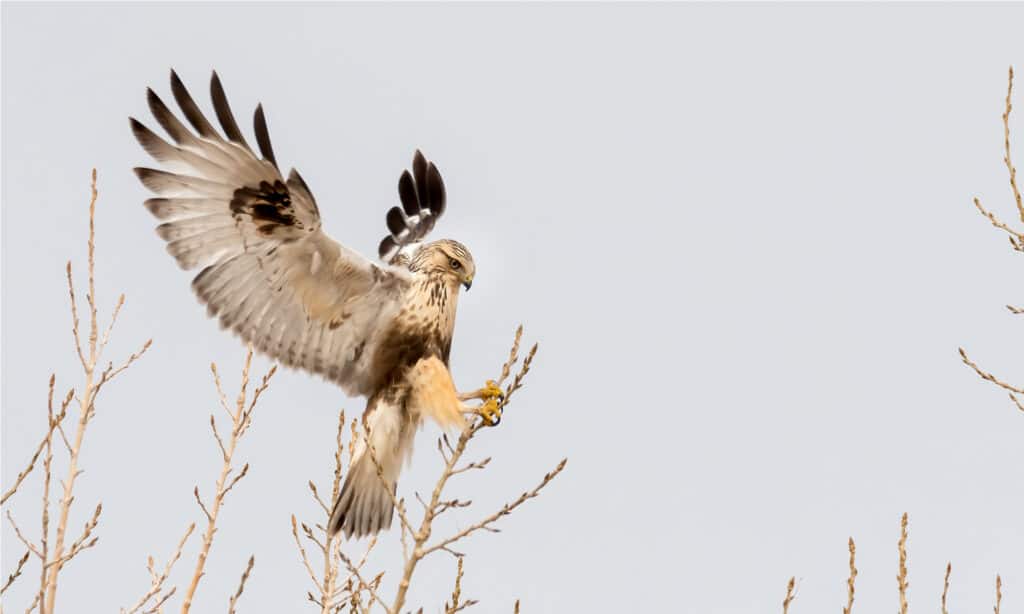
Eivor Kuchta/Shutterstock.com
| Rough-legged Hawk | |
|---|---|
| Scientific name | Buteo lagopus |
| Weight | 2.8 pounds |
| Height | 47-52 cm |
| Wingspan | 51 inches |
Rough-legged hawks are relatively large hawks commonly sighted in Maryland during winter. They are named after their unique feathered legs. They inhabit the arctic coasts and tundra escarpments and shift to open fields, marshes, and plains in winter. They are dark brown hawks with pale underwings.
Rough-legged hawks feed primarily on voles and lemmings during the breeding season and on carrion in winter. These raptors also feed on larger animals like rabbits and ground squirrels. They hunt by hovering over dense cover and open fields as they glance back and forth searching for prey.
Rough-legged hawks build their nests on the edge of a forest, on level ground, on a high cliff, or on a narrow ledge. Females lay between 3 and 5 pale bluish-white eggs, hatching in about 31 days. Females incubate the eggs, while males provide food for them during the entire incubation period.
2. Red-shouldered Hawk
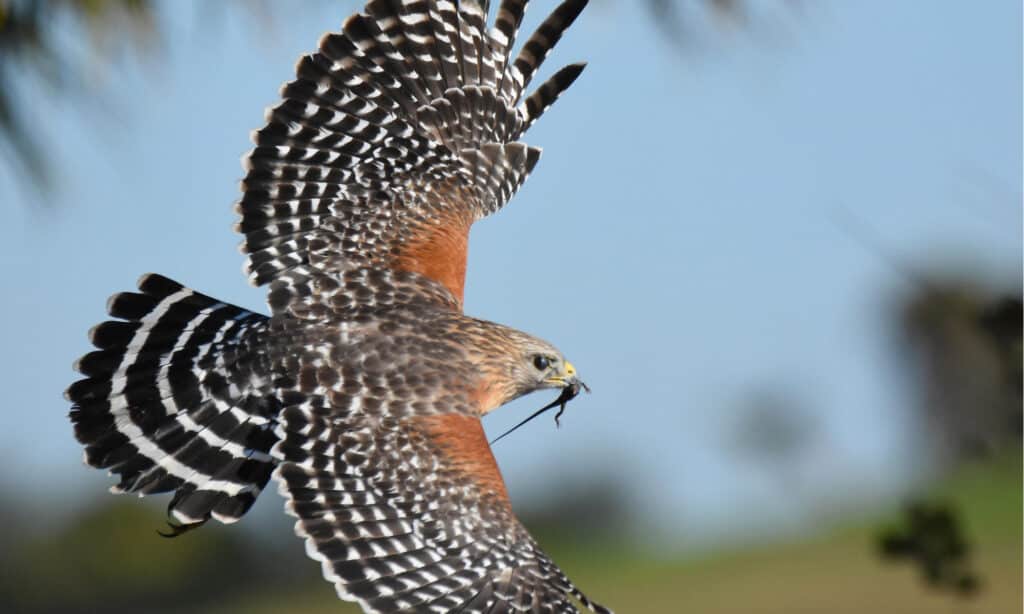
MTKhaled mahmud/Shutterstock.com
| Red-shouldered Hawk | |
|---|---|
| Scientific name | Buteo lineatus |
| Weight | 1.5 pounds |
| Height | 43-61 cm |
| Wingspan | 90-127 cm |
Red-shouldered hawks are medium-sized raptors found in Maryland throughout the year. They are often spotted in swamps, wooded streamsides, and bottomland woods. They have unique dark-and-white checkered wings that complement the reddish barring on their breasts.
Their diet consists of chipmunks, voles, toads, frogs, mice, small birds, snakes, and large insects. They hunt by perching on utility poles, hay bales, and fence posts. Once they spot prey, they swoop rapidly onto it from above.
Nesting sites are often in deciduous trees, sometimes in conifers. Red-shouldered hawks may reuse their nests for more than one season. Females lay 3-4 pale bluish-white eggs with brown spots. Eggs take roughly 33 days to hatch.
3. Northern Harrier

Harry Collins Photography/Shutterstock.com
| Northern Harrier | |
|---|---|
| Scientific name | Circus hudsonius |
| Weight | 0.5-1.3 pounds |
| Height | 46-50 cm |
| Wingspan | 102-118 cm |
Northern harriers are slim, long-tailed hawks that can be seen in Maryland throughout all the seasons. Males are gray on top with whitish undertips and dark wingtips. Females are brown above with black-banded tails. These raptors inhabit the prairies, marshes, and open fields.
Their diet consists of small birds, voles, mice, rats, lizards, toads, frogs, and other mammals. They feed on carrion, particularly in winter. They hunt by flying low over open fields. They circle the area so many times while listening and searching for prey.
Northern harriers nest in the marshes. Females build the nests while males supply the nesting materials. Females lay between 4-6 pale bluish-white eggs, which take around 30-32 days to hatch.
4. Sharp-shinned Hawk
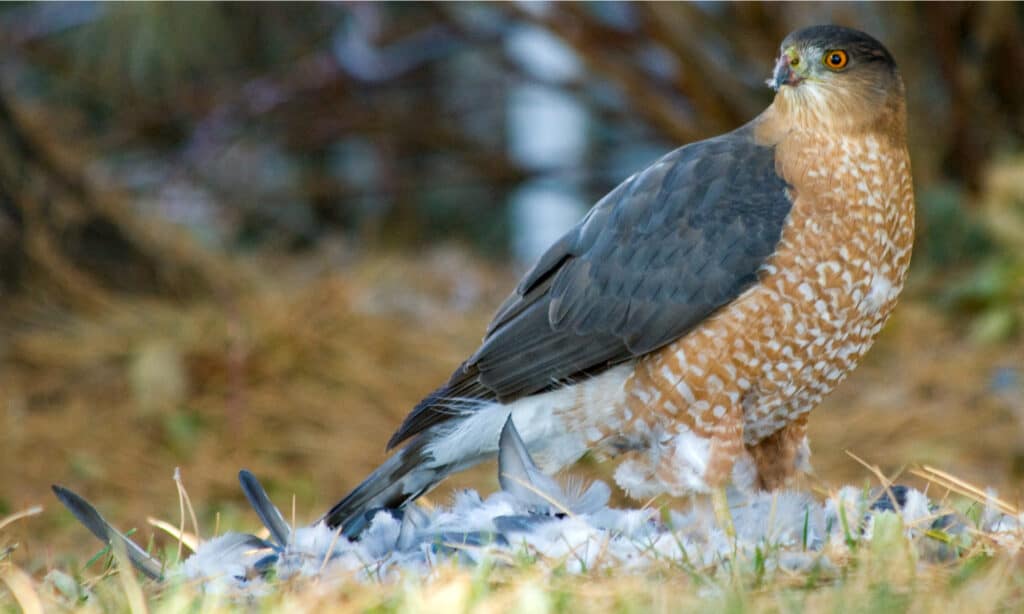
Wyatt W/Shutterstock.com
| Sharp-shinned Hawk | |
|---|---|
| Scientific name | Accipiter striatus |
| Weight | 1-2 pounds |
| Height | 24-34 cm |
| Wingspan | 19.6 inches |
Sharp-shinned hawks are slender, long-tailed birds of prey. They are highly migratory raptors but can be found in Maryland all year. They are perhaps the smallest hawks in the state. They inhabit open deciduous woodlands and mixed or pure coniferous forests.
Sharp-shinned hawks feed mainly on small birds like sparrows, robins, and quails. They also feed on rodents, reptiles, and large insects sometimes.
These hawks are very secretive birds of prey who conceal their nests in dense coniferous forests. Both sexes assemble nesting materials, but females do most of the construction. Females lay between 4-5 bluish-white eggs, which hatch in 30-35 days.
5. Cooper’s Hawk

Richard G Smith/Shutterstock.com
| Cooper’s Hawk | |
|---|---|
| Scientific name | Accipiter cooperii |
| Weight | 1-2 pounds |
| Height | 7-27 cm |
| Wingspan | 62-90 cm |
Cooper’s hawks are common woodland birds of prey found in Maryland. They also inhabit river groves, wood edges, and forests, apart from open woodlands. They feed primarily on small birds and mammals, usually hunting by stealth, approaching the prey silently through dense cover, then rapidly pounce on the unsuspecting prey.
Cooper’s hawks build nests in deciduous, coniferous, and mixed woods. They often renovate the old nests of other large birds and squirrels. Females lay between 3-5 pale bluish-white eggs, usually taking 34-36 days to hatch.
6. Red-tailed Hawk
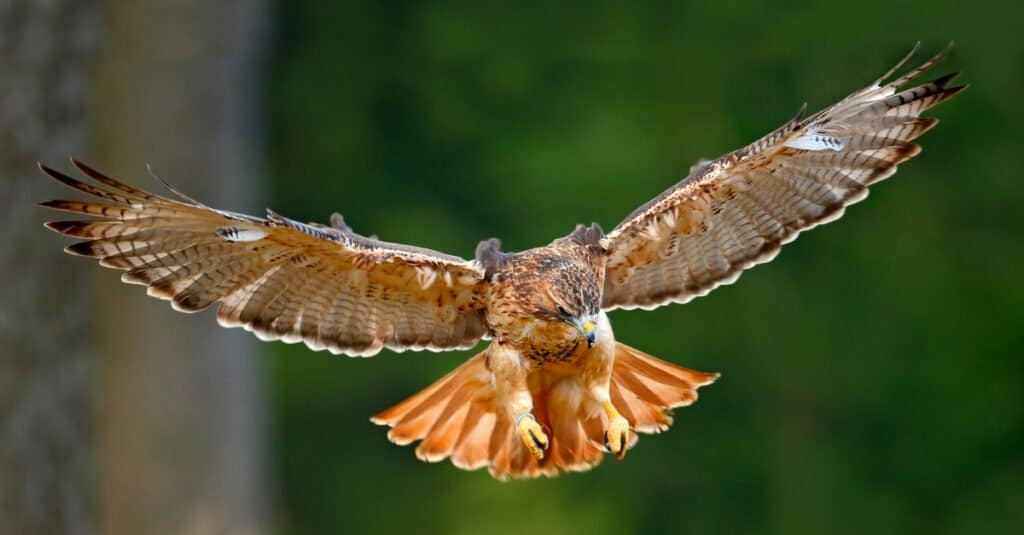
Ondrej Prosicky/Shutterstock.com
| Red-tailed Hawk | |
|---|---|
| Scientific name | Buteo jamaicensis |
| Weight | 2.75 pounds |
| Height | 17-25 inches |
| Wingspan | 45 to 56 inches |
Red-tailed hawks are the most widespread and familiar large birds of prey in Maryland. They are brown on top and pale underneath, with a streaked belly. They have a distinctive cinnamon-red tail. These raptors can be seen by the roadsides, mountains, prairie groves, and open country.
Red-tailed hawks have a diet that consists mainly of small birds, rats, voles, rabbits, snakes, frogs, toads, and large insects. They may also feed on carrion. They hunt by watching for prey from a perch. They swoop down to capture prey upon spotting one.
Their nesting sites vary. They may nest on cliff ledges, artificial structures, or tall trees. Both sexes build the nests. Females lay between 2-3 eggs with brown spots. The incubation period takes roughly 28-35 days and is done by both parents.
7. Broad-winged Hawk
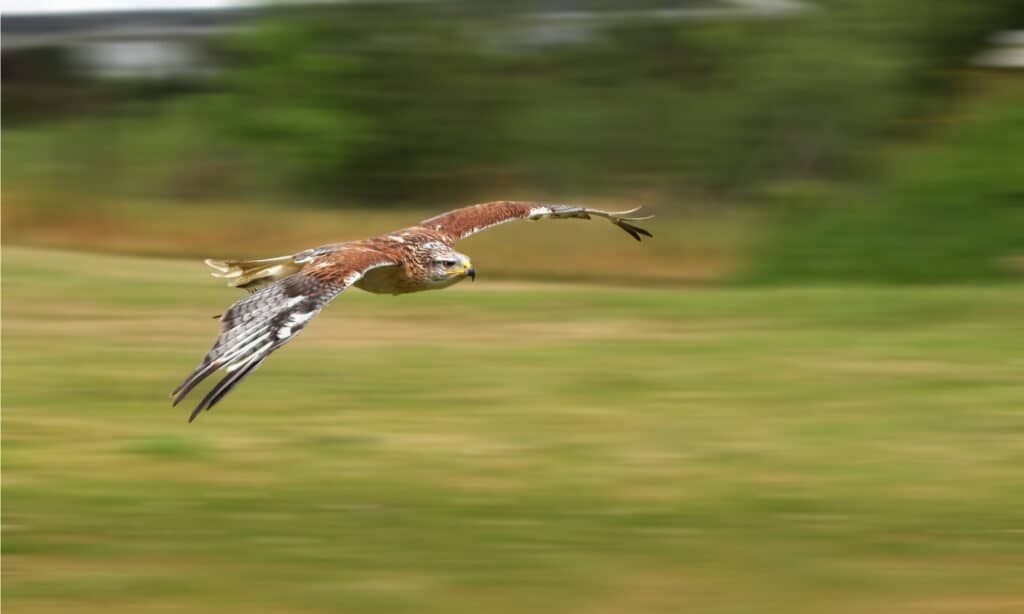
pr2is/Shutterstock.com
| Broad-winged Hawk | |
|---|---|
| Scientific name | Buteo platypterus |
| Weight | 2-4 pounds |
| Height | 34-44 cm |
| Wingspan | 35 inches |
Broad-winged hawks are small, compact birds of prey often sighted in Maryland all year. They have distinct chunky bodies and large heads. Broad-winged hawks have reddish-brown heads with black-and-white banded tails. They mainly inhabit the woods and groves. These hawks feed primarily on small mammals, birds, and reptiles.
Nesting sites consist of mixed coniferous-deciduous forest or pure coniferous trees, usually near edges, clearings, or water. They typically use pre-existing nests of squirrels and other large birds, only adding material to the nest. Females lay 2-3 whitish eggs with brown spots. Females incubate the eggs for 28-31 days.
8. Northern Goshawk

Milan Zygmunt/Shutterstock.com
| Northern Goshawk | |
|---|---|
| Scientific name | Accipiter gentilis |
| Weight | 3 pounds |
| Height | 53-64 cm |
| Wingspan | 103-117 cm |
Northern goshawks are the bulkiest and largest accipiters. They can be found in Maryland all year. They have distinctive long tails and rounded wings. They are dark slate gray on top with pale gray barred underneath. They mainly inhabit coniferous and deciduous forests.
Northern goshawks feed on medium-sized birds, snowshoe hares, rabbits, and many squirrels. They usually hunt along forest edges or inside the forest; they take prey by surprise by putting short bursts of flights.
The nest site is on trees at a major crotch in the tree trunk of a deciduous tree. Females often do nest building, and they are re-used for more than one season. Females lay between 2-4 bluish-white eggs that hatch in about 32-38 days.
More from A-Z Animals
.more-snake-card-image { max-height:140px !important; }
@media (min-width: 481px) {
.mobile-top-content {
display: none;
}
}
#mobileTopContentCTACarouselControls { overflow: hidden; text-overflow: ellipsis; white-space: nowrap; }
.mobile-top-content .more { color: #fff; }
.mobile-top-content a { color: #fff; text-decoration: underline; }
.mobile-top-content a:hover { color: #fff; text-decoration: underline; }
@media (max-width: 480px) {
.mobile-top-content {
background-color: #06a10b;
color: #fff;
text-align: center;
/*height: 60px;
padding-top:5px;*/
font-size:80%;
/* display: block; */
margin: 0px -30px;
}
}
Maryland is home to approximately 450 species of birds, making the state the most frequented birding destination in the United States. Some of the state’s best birding sites include the Chesapeake Bay and the Delmarva Peninsula, home to vast flocks of hawks and numerous nesting bald eagles.
Venture away from the Appalachian Mountains in the north into the far western parts of Maryland to see hawks and other bird species. You will come across a wide range of birds of prey in dense forests, marshes, and prairies.
Here are the 8 species of hawks that you’re most likely to encounter while exploring some of the birding hotspots in Maryland.
button.pulse {
transform: scale(1); animation: pulse 2s infinite;
box-shadow: 0 0 0 0 rgba(11, 247, 25, 1);
}
@keyframes pulse {
0% { transform: scale(0.90); box-shadow: 0 0 0 0 rgba(11, 247, 25, 0.5); }
60% { transform: scale(1); box-shadow: 0 0 0 15px rgba(11, 247, 25, 0); }
100% { transform: scale(0.90); box-shadow: 0 0 0 0 rgba(11, 247, 25, 0); }
}
1. Rough-legged Hawk

Eivor Kuchta/Shutterstock.com
| Rough-legged Hawk | |
|---|---|
| Scientific name | Buteo lagopus |
| Weight | 2.8 pounds |
| Height | 47-52 cm |
| Wingspan | 51 inches |
Rough-legged hawks are relatively large hawks commonly sighted in Maryland during winter. They are named after their unique feathered legs. They inhabit the arctic coasts and tundra escarpments and shift to open fields, marshes, and plains in winter. They are dark brown hawks with pale underwings.
Rough-legged hawks feed primarily on voles and lemmings during the breeding season and on carrion in winter. These raptors also feed on larger animals like rabbits and ground squirrels. They hunt by hovering over dense cover and open fields as they glance back and forth searching for prey.
Rough-legged hawks build their nests on the edge of a forest, on level ground, on a high cliff, or on a narrow ledge. Females lay between 3 and 5 pale bluish-white eggs, hatching in about 31 days. Females incubate the eggs, while males provide food for them during the entire incubation period.
2. Red-shouldered Hawk

MTKhaled mahmud/Shutterstock.com
| Red-shouldered Hawk | |
|---|---|
| Scientific name | Buteo lineatus |
| Weight | 1.5 pounds |
| Height | 43-61 cm |
| Wingspan | 90-127 cm |
Red-shouldered hawks are medium-sized raptors found in Maryland throughout the year. They are often spotted in swamps, wooded streamsides, and bottomland woods. They have unique dark-and-white checkered wings that complement the reddish barring on their breasts.
Their diet consists of chipmunks, voles, toads, frogs, mice, small birds, snakes, and large insects. They hunt by perching on utility poles, hay bales, and fence posts. Once they spot prey, they swoop rapidly onto it from above.
Nesting sites are often in deciduous trees, sometimes in conifers. Red-shouldered hawks may reuse their nests for more than one season. Females lay 3-4 pale bluish-white eggs with brown spots. Eggs take roughly 33 days to hatch.
3. Northern Harrier

Harry Collins Photography/Shutterstock.com
| Northern Harrier | |
|---|---|
| Scientific name | Circus hudsonius |
| Weight | 0.5-1.3 pounds |
| Height | 46-50 cm |
| Wingspan | 102-118 cm |
Northern harriers are slim, long-tailed hawks that can be seen in Maryland throughout all the seasons. Males are gray on top with whitish undertips and dark wingtips. Females are brown above with black-banded tails. These raptors inhabit the prairies, marshes, and open fields.
Their diet consists of small birds, voles, mice, rats, lizards, toads, frogs, and other mammals. They feed on carrion, particularly in winter. They hunt by flying low over open fields. They circle the area so many times while listening and searching for prey.
Northern harriers nest in the marshes. Females build the nests while males supply the nesting materials. Females lay between 4-6 pale bluish-white eggs, which take around 30-32 days to hatch.
4. Sharp-shinned Hawk

Wyatt W/Shutterstock.com
| Sharp-shinned Hawk | |
|---|---|
| Scientific name | Accipiter striatus |
| Weight | 1-2 pounds |
| Height | 24-34 cm |
| Wingspan | 19.6 inches |
Sharp-shinned hawks are slender, long-tailed birds of prey. They are highly migratory raptors but can be found in Maryland all year. They are perhaps the smallest hawks in the state. They inhabit open deciduous woodlands and mixed or pure coniferous forests.
Sharp-shinned hawks feed mainly on small birds like sparrows, robins, and quails. They also feed on rodents, reptiles, and large insects sometimes.
These hawks are very secretive birds of prey who conceal their nests in dense coniferous forests. Both sexes assemble nesting materials, but females do most of the construction. Females lay between 4-5 bluish-white eggs, which hatch in 30-35 days.
5. Cooper’s Hawk

Richard G Smith/Shutterstock.com
| Cooper’s Hawk | |
|---|---|
| Scientific name | Accipiter cooperii |
| Weight | 1-2 pounds |
| Height | 7-27 cm |
| Wingspan | 62-90 cm |
Cooper’s hawks are common woodland birds of prey found in Maryland. They also inhabit river groves, wood edges, and forests, apart from open woodlands. They feed primarily on small birds and mammals, usually hunting by stealth, approaching the prey silently through dense cover, then rapidly pounce on the unsuspecting prey.
Cooper’s hawks build nests in deciduous, coniferous, and mixed woods. They often renovate the old nests of other large birds and squirrels. Females lay between 3-5 pale bluish-white eggs, usually taking 34-36 days to hatch.
6. Red-tailed Hawk

Ondrej Prosicky/Shutterstock.com
| Red-tailed Hawk | |
|---|---|
| Scientific name | Buteo jamaicensis |
| Weight | 2.75 pounds |
| Height | 17-25 inches |
| Wingspan | 45 to 56 inches |
Red-tailed hawks are the most widespread and familiar large birds of prey in Maryland. They are brown on top and pale underneath, with a streaked belly. They have a distinctive cinnamon-red tail. These raptors can be seen by the roadsides, mountains, prairie groves, and open country.
Red-tailed hawks have a diet that consists mainly of small birds, rats, voles, rabbits, snakes, frogs, toads, and large insects. They may also feed on carrion. They hunt by watching for prey from a perch. They swoop down to capture prey upon spotting one.
Their nesting sites vary. They may nest on cliff ledges, artificial structures, or tall trees. Both sexes build the nests. Females lay between 2-3 eggs with brown spots. The incubation period takes roughly 28-35 days and is done by both parents.
7. Broad-winged Hawk

pr2is/Shutterstock.com
| Broad-winged Hawk | |
|---|---|
| Scientific name | Buteo platypterus |
| Weight | 2-4 pounds |
| Height | 34-44 cm |
| Wingspan | 35 inches |
Broad-winged hawks are small, compact birds of prey often sighted in Maryland all year. They have distinct chunky bodies and large heads. Broad-winged hawks have reddish-brown heads with black-and-white banded tails. They mainly inhabit the woods and groves. These hawks feed primarily on small mammals, birds, and reptiles.
Nesting sites consist of mixed coniferous-deciduous forest or pure coniferous trees, usually near edges, clearings, or water. They typically use pre-existing nests of squirrels and other large birds, only adding material to the nest. Females lay 2-3 whitish eggs with brown spots. Females incubate the eggs for 28-31 days.
8. Northern Goshawk

Milan Zygmunt/Shutterstock.com
| Northern Goshawk | |
|---|---|
| Scientific name | Accipiter gentilis |
| Weight | 3 pounds |
| Height | 53-64 cm |
| Wingspan | 103-117 cm |
Northern goshawks are the bulkiest and largest accipiters. They can be found in Maryland all year. They have distinctive long tails and rounded wings. They are dark slate gray on top with pale gray barred underneath. They mainly inhabit coniferous and deciduous forests.
Northern goshawks feed on medium-sized birds, snowshoe hares, rabbits, and many squirrels. They usually hunt along forest edges or inside the forest; they take prey by surprise by putting short bursts of flights.
The nest site is on trees at a major crotch in the tree trunk of a deciduous tree. Females often do nest building, and they are re-used for more than one season. Females lay between 2-4 bluish-white eggs that hatch in about 32-38 days.

